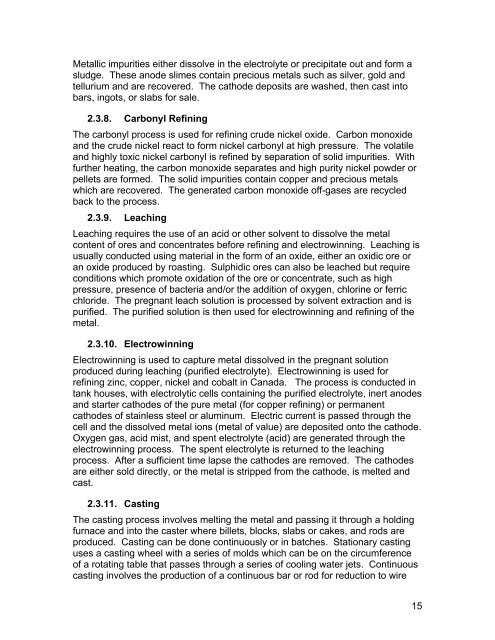(MERAF) for the Base Metals Smelting Sector - CCME
(MERAF) for the Base Metals Smelting Sector - CCME
(MERAF) for the Base Metals Smelting Sector - CCME
You also want an ePaper? Increase the reach of your titles
YUMPU automatically turns print PDFs into web optimized ePapers that Google loves.
Metallic impurities ei<strong>the</strong>r dissolve in <strong>the</strong> electrolyte or precipitate out and <strong>for</strong>m a<br />
sludge. These anode slimes contain precious metals such as silver, gold and<br />
tellurium and are recovered. The cathode deposits are washed, <strong>the</strong>n cast into<br />
bars, ingots, or slabs <strong>for</strong> sale.<br />
2.3.8. Carbonyl Refining<br />
The carbonyl process is used <strong>for</strong> refining crude nickel oxide. Carbon monoxide<br />
and <strong>the</strong> crude nickel react to <strong>for</strong>m nickel carbonyl at high pressure. The volatile<br />
and highly toxic nickel carbonyl is refined by separation of solid impurities. With<br />
fur<strong>the</strong>r heating, <strong>the</strong> carbon monoxide separates and high purity nickel powder or<br />
pellets are <strong>for</strong>med. The solid impurities contain copper and precious metals<br />
which are recovered. The generated carbon monoxide off-gases are recycled<br />
back to <strong>the</strong> process.<br />
2.3.9. Leaching<br />
Leaching requires <strong>the</strong> use of an acid or o<strong>the</strong>r solvent to dissolve <strong>the</strong> metal<br />
content of ores and concentrates be<strong>for</strong>e refining and electrowinning. Leaching is<br />
usually conducted using material in <strong>the</strong> <strong>for</strong>m of an oxide, ei<strong>the</strong>r an oxidic ore or<br />
an oxide produced by roasting. Sulphidic ores can also be leached but require<br />
conditions which promote oxidation of <strong>the</strong> ore or concentrate, such as high<br />
pressure, presence of bacteria and/or <strong>the</strong> addition of oxygen, chlorine or ferric<br />
chloride. The pregnant leach solution is processed by solvent extraction and is<br />
purified. The purified solution is <strong>the</strong>n used <strong>for</strong> electrowinning and refining of <strong>the</strong><br />
metal.<br />
2.3.10. Electrowinning<br />
Electrowinning is used to capture metal dissolved in <strong>the</strong> pregnant solution<br />
produced during leaching (purified electrolyte). Electrowinning is used <strong>for</strong><br />
refining zinc, copper, nickel and cobalt in Canada. The process is conducted in<br />
tank houses, with electrolytic cells containing <strong>the</strong> purified electrolyte, inert anodes<br />
and starter cathodes of <strong>the</strong> pure metal (<strong>for</strong> copper refining) or permanent<br />
cathodes of stainless steel or aluminum. Electric current is passed through <strong>the</strong><br />
cell and <strong>the</strong> dissolved metal ions (metal of value) are deposited onto <strong>the</strong> cathode.<br />
Oxygen gas, acid mist, and spent electrolyte (acid) are generated through <strong>the</strong><br />
electrowinning process. The spent electrolyte is returned to <strong>the</strong> leaching<br />
process. After a sufficient time lapse <strong>the</strong> cathodes are removed. The cathodes<br />
are ei<strong>the</strong>r sold directly, or <strong>the</strong> metal is stripped from <strong>the</strong> cathode, is melted and<br />
cast.<br />
2.3.11. Casting<br />
The casting process involves melting <strong>the</strong> metal and passing it through a holding<br />
furnace and into <strong>the</strong> caster where billets, blocks, slabs or cakes, and rods are<br />
produced. Casting can be done continuously or in batches. Stationary casting<br />
uses a casting wheel with a series of molds which can be on <strong>the</strong> circumference<br />
of a rotating table that passes through a series of cooling water jets. Continuous<br />
casting involves <strong>the</strong> production of a continuous bar or rod <strong>for</strong> reduction to wire<br />
15
















